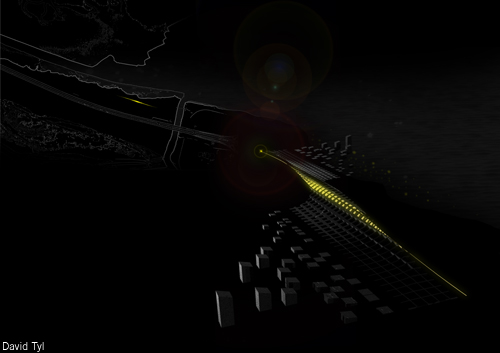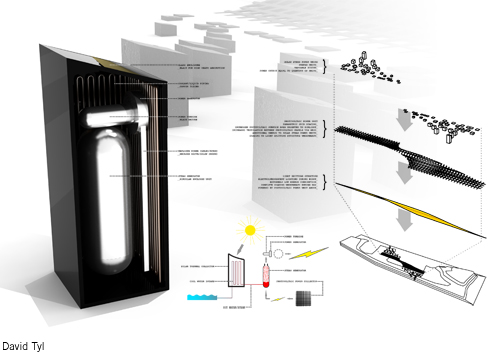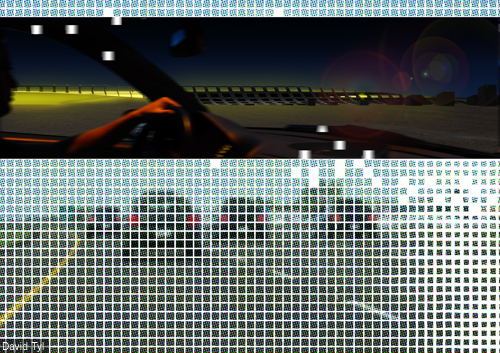David Tyl
Designed for Site #2 in Abu Dhabi, between Saadiyat Island and Yas Island.

Design Submission for the 2010 Land Art Generator Initiative Design Competition
Artist’s descriptive text:
The following project is an essay on culture, combined with thoughts on progress and sustainability. It is meant both to interpret the landscape by connecting physical structure with natural environment, and to convey new ideas of sustainability and wonderment with regard to our current conception of energy generating devices. Primarily, it is meant as a sculptural device existing in the landscape, bridging the natural with the synthetic, the physical with the surreal, and expressing ideas of evolution, continuity, and the infinite cycle. It is also meant to stimulate thoughts on science, religion, and culture to all those who experience it.

The form of the structure is an investigation into interior spaces and privacy, leading to questions about the public realm and enlightenment. In skewing the boundaries between inside and outside spaces, the structure attempts to define what is meant to conceal, and what is meant to uncover. It brings about the notion of importance, and asks what becomes relevant to the argument; does one look to the outside from within, or vice versa? Where is the exterior, and to what are we to put focus on? Are we to attend to the natural landscape of the environment, or the speed and evolution of human progress? Where is the boundary?

In generating power, the structure makes use of two of the earths most abundant and renewable resources: water and sun. By using the two in a balanced manner, the idea is to create energy without the necessity for additional support in terms of non-renewable resources. By superheating the water that is local to the site (Site #2), by means of solar energy, there may exist enough energy and velocity to power turbines that will in turn generate useable power to the community. Solar power is thus used in two ways, that is, by way of directly heating the water that circulates through each ‘cube’ of the structure to create steam, and by way of photovoltaic panels that are attached to the grid portion of the structure – energy that is used primarily to assist in superheating the water to create steam. The result is clean useable energy that is created from merely water and sun.

Experiencing the structure is done in numerous ways; from a distance, within, and directly underneath. One may first come into contact with it visually from the sky (in an airplane), and again along the highway (in an automobile), and again within it walking among the ‘cubes’, and finally underneath it walking beneath the light emissive spiraled plane. The structure creates a visual impact both during the day and at night when it is lit. Low-energy electroluminescent lighting enables the structure to attract attention far and wide, creating a distinct image for the community that depicts sustainability, safety, power, and change. There is thus no time of day that the structure may not be experienced.
Related Posts
1 Comment
Add comment Cancel reply
This site uses Akismet to reduce spam. Learn how your comment data is processed.

[…] power, and change. There is thus no time of day that the structure may not be experienced. Source: Land Art Generator Initiative Reageer […]